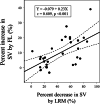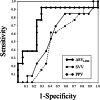Changes in stroke volume induced by lung recruitment maneuver can predict fluid responsiveness during intraoperative lung-protective ventilation in prone position
- PMID: 34856928
- PMCID: PMC8638171
- DOI: 10.1186/s12871-021-01527-y
Changes in stroke volume induced by lung recruitment maneuver can predict fluid responsiveness during intraoperative lung-protective ventilation in prone position
Abstract
Background: The present study aimed to evaluate the reliability of hemodynamic changes induced by lung recruitment maneuver (LRM) in predicting stroke volume (SV) increase after fluid loading (FL) in prone position.
Methods: Thirty patients undergoing spine surgery in prone position were enrolled. Lung-protective ventilation (tidal volume, 6-7 mL/kg; positive end-expiratory pressure, 5 cmH2O) was provided to all patients. LRM (30 cmH2O for 30 s) was performed. Hemodynamic variables including mean arterial pressure (MAP), heart rate, SV, SV variation (SVV), and pulse pressure variation (PPV) were simultaneously recorded before, during, and at 5 min after LRM and after FL (250 mL in 10 min). Receiver operating characteristic curves were generated to evaluate the predictability of SVV, PPV, and SV decrease by LRM (ΔSVLRM) for SV responders (SV increase after FL > 10%). The gray zone approach was applied for ΔSVLRM.
Results: Areas under the curve (AUCs) for ΔSVLRM, SVV, and PPV to predict SV responders were 0.778 (95% confidence interval: 0.590-0.909), 0.563 (0.371-0.743), and 0.502 (0.315-0.689), respectively. The optimal threshold for ΔSVLRM was 30% (sensitivity, 92.3%; specificity, 70.6%). With the gray zone approach, the inconclusive values ranged 25 to 75% for ΔSVLRM (including 50% of enrolled patients).
Conclusion: In prone position, LRM-induced SV decrease predicted SV increase after FL with higher reliability than traditional dynamic indices. On the other hand, considering the relatively large gray zone in this study, future research is needed to further improve the clinical significance.
Trial registration: UMIN Clinical Trial Registry UMIN000027966 . Registered 28th June 2017.
Keywords: Fluid responsiveness; Lung recruitment maneuver; Prone position; Stroke volume.
© 2021. The Author(s).
Conflict of interest statement
Dr. Suehiro has received speaker fees from Edwards Lifesciences and Otsuka Pharmaceutical Co. Ltd. Other authors have no conflicts of interest to declare.
Figures






Similar articles
-
The Hemodynamic Changes Induced by Lung Recruitment Maneuver to Predict Fluid Responsiveness in Children during One Lung Ventilation-A Prospective Observational Study.Children (Basel). 2024 May 27;11(6):649. doi: 10.3390/children11060649. Children (Basel). 2024. PMID: 38929229 Free PMC article.
-
Hemodynamic Changes via the Lung Recruitment Maneuver Can Predict Fluid Responsiveness in Stroke Volume and Arterial Pressure During One-Lung Ventilation.Anesth Analg. 2021 Jul 1;133(1):44-52. doi: 10.1213/ANE.0000000000005375. Anesth Analg. 2021. PMID: 33687175
-
Use of stepwise lung recruitment maneuver to predict fluid responsiveness under lung protective ventilation in the operating room.Sci Rep. 2024 May 22;14(1):11649. doi: 10.1038/s41598-024-62355-x. Sci Rep. 2024. PMID: 38773192 Free PMC article.
-
Reliability of pulse pressure and stroke volume variation in assessing fluid responsiveness in the operating room: a metanalysis and a metaregression.Crit Care. 2023 Nov 8;27(1):431. doi: 10.1186/s13054-023-04706-0. Crit Care. 2023. PMID: 37940953 Free PMC article.
-
Stroke volume variation induced by lung recruitment maneuver to predict fluid responsiveness in patients receiving mechanical ventilation: A systematic review and meta-analysis.J Clin Anesth. 2024 Oct;97:111545. doi: 10.1016/j.jclinane.2024.111545. Epub 2024 Jul 5. J Clin Anesth. 2024. PMID: 38971135
Cited by
-
Incidence, characteristics and risk factors for alveolar recruitment maneuver-related hypotension in patients undergoing laparoscopic colorectal cancer resection.World J Gastrointest Surg. 2023 Jul 27;15(7):1454-1464. doi: 10.4240/wjgs.v15.i7.1454. World J Gastrointest Surg. 2023. PMID: 37555120 Free PMC article.
-
Prediction of Fluid Responsiveness by the Effect of the Lung Recruitment Maneuver on the Perfusion Index in Mechanically Ventilated Patients During Surgery.Front Med (Lausanne). 2022 Jun 17;9:881267. doi: 10.3389/fmed.2022.881267. eCollection 2022. Front Med (Lausanne). 2022. PMID: 35783653 Free PMC article.
-
The Hemodynamic Changes Induced by Lung Recruitment Maneuver to Predict Fluid Responsiveness in Children during One Lung Ventilation-A Prospective Observational Study.Children (Basel). 2024 May 27;11(6):649. doi: 10.3390/children11060649. Children (Basel). 2024. PMID: 38929229 Free PMC article.
-
The Impact of Individualized Hemodynamic Management on Intraoperative Fluid Balance and Hemodynamic Interventions during Spine Surgery in the Prone Position: A Prospective Randomized Trial.Medicina (Kaunas). 2022 Nov 20;58(11):1683. doi: 10.3390/medicina58111683. Medicina (Kaunas). 2022. PMID: 36422222 Free PMC article. Clinical Trial.
-
Variations of pulse pressure and central venous pressure may predict fluid responsiveness in mechanically ventilated patients during lung recruitment manoeuvre: an ancillary study.BMC Anesthesiol. 2022 Aug 23;22(1):269. doi: 10.1186/s12871-022-01815-1. BMC Anesthesiol. 2022. PMID: 35999508 Free PMC article.
References
-
- Thacker JK, Mountford WK, Ernst FR, Krukas MR, Mythen MM. Perioperative fluid utilization variability and association with outcomes: considerations for enhanced recovery efforts in sample US surgical populations. Ann Surg. 2016;263(3):502–510. - PubMed
-
- Pearse RM, Harrison DA, MacDonald N, Gillies MA, Blunt M, Ackland G, et al. Effect of a perioperative, cardiac output-guided hemodynamic therapy algorithm on outcomes following major gastrointestinal surgery: a randomized clinical trial and systematic review. JAMA. 2014;311(21):2181–2190. - PubMed
-
- Bellamy MC. Wet, dry or something else? Br J Anaesth. 2006;97(6):755–757. - PubMed
-
- Oh TK, Song IA, Do SH, Jheon S, Lim C. Association of perioperative weight-based fluid balance with 30-day mortality and acute kidney injury among patients in the surgical intensive care unit. J Anesth. 2019;33(3):354–363. - PubMed
Publication types
MeSH terms
Associated data
- Actions
LinkOut - more resources
Full Text Sources
Medical

